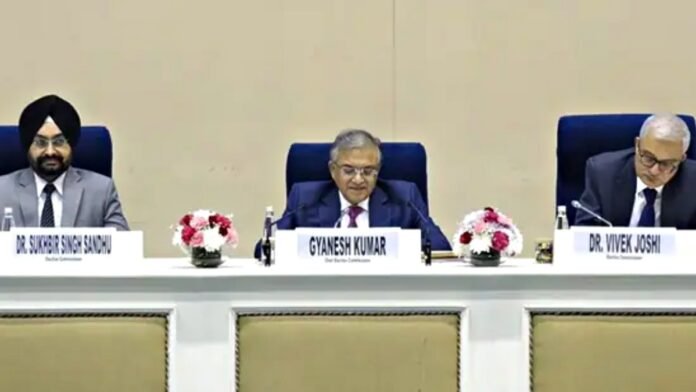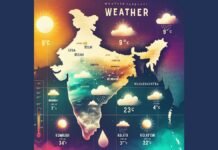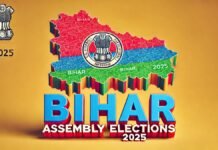
Key Points
- Second phase of Special Intensive Revision (SIR) begins in 12 states from October 28, 2025
- Voter lists to be frozen from midnight tonight; special enumeration forms to be distributed to all voters
- Three forms available: Form 6 (adding new voters), Form 7 (deletion), Form 8 (corrections)
- Voters can choose from 12 different document types for verification including passport, birth certificate, and educational certificates
- Bihar’s 75 million voters completed the first phase with zero complaints
- Election Commission held detailed consultations with officials from all states and union territories
- Final draft voter list to be published on February 7, 2026
New Delhi: Chief Election Commissioner Gyanesh Kumar announced the commencement of the second phase of Special Intensive Revision (SIR) at a press conference on Monday, stating, “Today we are here with the rollout of the second phase.” The voter lists in 12 targeted states will be frozen starting midnight on October 27, 2025, marking a critical step in the nationwide electoral roll cleanup exercise.
The Election Commission has concluded comprehensive consultations with election officials from all states and union territories to finalize the implementation process. This coordinated approach ensures uniformity in execution while addressing region-specific challenges in voter list management.
Bihar Success Provides Blueprint
Chief Election Commissioner Gyanesh Kumar expressed gratitude to Bihar’s 75 million voters for making the first phase a resounding success. The state’s experience has provided valuable insights into best practices and helped refine the procedures for the second phase. The zero-complaint achievement in Bihar has set a high benchmark for other states to follow.
Special Enumeration Forms for Every Voter
Once the voter lists are frozen at midnight tonight, a crucial new step will be implemented: the distribution of special enumeration forms to every registered voter. These forms will require voters to fill in all previously available details, creating a comprehensive verification mechanism. This proactive approach ensures that all voter information is cross-checked and validated, rather than relying solely on passive verification by election officials.
Three-Form System for Voter List Updates
The Election Commission has streamlined the voter list update process through three distinct forms, each serving a specific purpose:
Form 6 – Adding New Voters: New voters or those not yet included in the electoral roll can register themselves using Form 6. This applies to citizens who have recently turned 18 years old or those who have never been registered despite being eligible. The form requires basic details along with proof of residence and identity verification.
Form 7 – Voter Deletion: This form enables voters to request removal from the electoral roll in specific circumstances. Common scenarios include voters who have relocated to another constituency, duplicate entries where a person is registered in multiple locations, or cases where deceased individuals’ names need to be removed. Form 7 helps clean up the voter list by eliminating ineligible or redundant entries.
Form 8 – Corrections and Modifications: Voters who need to update information on their voter cards, such as correcting spelling errors in names, updating addresses, changing photographs, or modifying other personal details, can use Form 8. This form is crucial for maintaining accuracy in voter records without requiring complete re-registration.
12 Document Options for Flexible Verification
In a significant move to ensure accessibility and inclusivity, the Election Commission has approved 12 different document types for voter verification. Chief Election Commissioner Gyanesh Kumar emphasized that this diverse document list ensures no eligible voter is excluded due to documentation constraints.
The approved documents provide multiple pathways for establishing identity and residence:
Government-Issued Identity Documents: A Passport serves as primary proof of identity and citizenship. Pension payment orders issued by central or state governments verify senior citizens and retired government employees.
Educational Credentials: Educational certificates from recognized institutions can be used as proof of identity and age verification, particularly beneficial for young voters registering for the first time.
Residence and Property Documents: Permanent residence certificates issued by competent authorities establish domicile status. Land or house allotment certificates prove both residence and property ownership. Family registers maintained by local authorities can verify familial connections and residential history.
Birth and Vital Records: Birth certificates provide definitive proof of age and citizenship, essential for first-time voters.
Banking and Financial Documents: Certificates issued by banks, post offices, or Life Insurance Corporation (LIC) demonstrate financial identity and can support residence verification through account addresses.
Local Authority Certificates: Certificates issued by government departments, local bodies, or panchayats serve as community-backed verification of identity and residence.
Special Category Documents: Forest rights certificates establish identity for tribal communities with traditional forest land rights. Caste certificates serve dual purposes of identity verification and ensuring reservation benefits reach intended beneficiaries.
National Register of Citizens (NRC): In states where NRC has been implemented, particularly in Assam, it serves as definitive proof of citizenship and can be used for voter registration verification.
Enhanced Verification Process
The 12-document system represents a carefully calibrated balance between electoral integrity and voter accessibility. By accepting multiple document types, the Commission acknowledges India’s diverse documentation landscape, where different population segments may have access to different forms of identification.
This flexibility is particularly important for marginalized communities, rural populations, and first-time voters who may not possess traditional identity documents like passports or driving licenses. The inclusion of community-based verification through local authority certificates and family registers ensures that genuine voters are not disenfranchised due to documentation gaps.
Implementation Timeline and Coverage
The SIR second phase covers 12 states and union territories: Andaman and Nicobar Islands, Chhattisgarh, Goa, Gujarat, Kerala, Lakshadweep, Madhya Pradesh, Puducherry, Rajasthan, Tamil Nadu, Uttar Pradesh, and West Bengal. The process will run until early February 2026, with the final draft voter list scheduled for publication on February 7, 2026.
The midnight freeze marks the beginning of an intensive verification period where Booth Level Officers will conduct household visits, distribute enumeration forms, and collect verification documents. Voters will have multiple opportunities throughout this period to submit their chosen documents from the approved list and resolve any discrepancies in their registration details.
The Election Commission has assured that adequate grievance redressal mechanisms will be in place, allowing voters to address concerns about deletions, corrections, or additions to the electoral roll. This comprehensive approach aims to create the most accurate and inclusive voter list in India’s electoral history, strengthening democratic participation ahead of the 2026 assembly elections.





















































